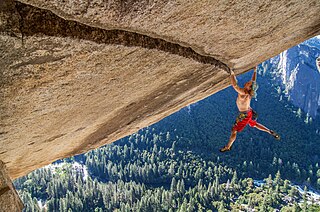
Climbing is the activity of using one's hands, feet, or other parts of the body to ascend a steep topographical object that can range from the world's tallest mountains to small boulders. Climbing is done for locomotion, sporting recreation, for competition, and is also done in trades that rely on ascension, such as rescue and military operations. Climbing is done indoors and outdoors, on natural surfaces, and on artificial surfaces

Gymnastics is a type of sport that includes physical exercises requiring balance, strength, flexibility, agility, coordination, artistry and endurance. The movements involved in gymnastics contribute to the development of the arms, legs, shoulders, back, chest, and abdominal muscle groups. Gymnastics evolved from exercises used by the ancient Greeks that included skills for mounting and dismounting a horse, and from circus performance skills.

Rhythmic gymnastics is a sport in which gymnasts perform on a floor with an apparatus: hoop, ball, clubs, ribbon and rope. The sport combines elements of gymnastics, dance and calisthenics; gymnasts must be strong, flexible, agile, dexterous and coordinated. Rhythmic gymnastics is governed by the International Gymnastics Federation (FIG), which first recognized it as a sport in 1963. It became an Olympic sport in 1984, with an individual all-around event. The group all-around competition was added to the Olympics in 1996. At the international level, rhythmic gymnastics is a women-only sport. The most prestigious competitions, besides the Olympic Games, are the World Championships, World Games, European Championships, European Games, the World Cup Series and the Grand Prix Series. Gymnasts are judged on their artistry, execution of skills, and difficulty of skills, for which they gain points. They perform leaps, balances, and rotations along with handling the apparatus.
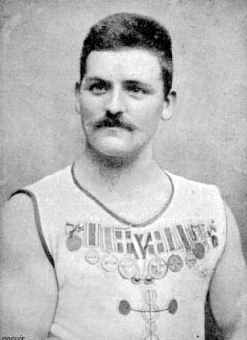
Alexander Viggo Jensen was a Danish weightlifter, sport shooter, gymnast, and athlete. He was the first Danish and Nordic Olympic champion, at the 1896 Summer Olympics in Athens.

At the 1900 Summer Olympics one gymnastics event for men was contested. The competition was held on Sunday, 29 July 1900, and on Monday, 30 July 1900. There were 135 competitors from 8 nations. The top 18 places were taken by French gymnasts, of which there were more than 100. The event was won by Gustave Sandras, with Noël Bas finishing second and Lucien Démanet third. The highest-placing foreign gymnast was Jules Ducret of Switzerland, in a tie for 19th place.

Yordan Yovchev Yovchev, also spelled Jordan Jovtchev, is a retired Bulgarian gymnast. He took part in six consecutive Olympic Games, more than any other Bulgarian athlete in Olympic history. He is president of the Bulgarian Gymnastics Federation and also serves as a sports commentator.
Fritz Hofmann was a German athlete. He competed at the 1896 Summer Olympics in Athens.
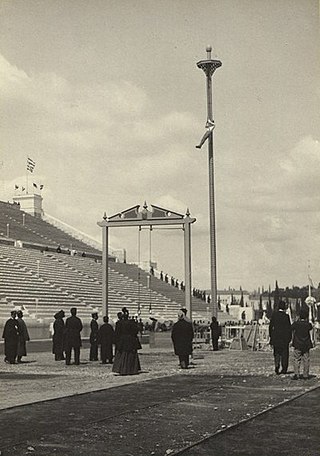
The men's rope climbing was one of eight gymnastics events on the Gymnastics at the 1896 Summer Olympics programme. The final event in the gymnastics competition, rope climbing was held on 10 April. The rope was 14 metres long, suspended from a frame. Time and style were considered in placing the competitors who reached the top and distance climbed separating those who did not make it all the way up. Five competitors entered, with the two Greeks taking top honors by being the only two to complete the climb. The German Fritz Hofmann won the bronze medal, while the weightlifting champions Viggo Jensen and Launceston Elliot finished fourth and fifth.

The men's individual all-around, also known as the heptathlon, was one of two gymnastics events on the Gymnastics at the 1908 Summer Olympics programme. As suggested by the alternate name, the competition included seven events with the scores summed to give a final score. Each nation could enter up to 20 gymnasts, with France and Great Britain each entering the maximum. A total of 97 gymnasts from 12 nations competed. The event was won by Alberto Braglia of Italy, the nation's first medal in the men's individual all-around. Silver went to Walter Tysall of Great Britain, the first medal for the nation as well. France's Louis Ségura earned bronze.
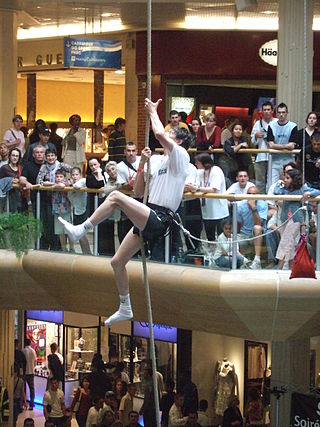
Rope climbing is a sport in which competitors attempt to climb up a suspended vertical rope using only their hands. Rope climbing is practiced regularly at the World Police and Fire Games, and is enjoying a resurgence in France, where competitions are held in shopping centers. Also, enthusiasts in the Czech Republic resurrected the sport in 1993, and hold local and national competitions.
At the 1928 Summer Olympics in Amsterdam, eight events in gymnastics were contested. For the first time at the Olympic Games, women competed in gymnastics. The rope climbing and sidehorse vault events were dropped from the program.

The men's rope climbing was an artistic gymnastics event held as part of the gymnastics programme at the 1904 Summer Olympics. It was the second time the event was held at the Olympics. An unknown number of gymnasts competed; only three are known, all American. The competition was held on Friday, October 28, 1904. George Eyser won the event, with Charles Krause second and Emil Voigt third.

Mallakhamba, or mallakhamb is a traditional sport, originating from the Indian subcontinent, in which a group of gymnasts perform aerial yoga and gymnastic postures using wrestling grips in concert with a stationary vertical pole. The word "mallakhamb" also refers to the pole used in the sport. The pole is usually made from sheesham polished with castor oil. Other popular versions of mallakhamba are practiced using a cane or a rope instead of a pole. The origins of pole dancing can be traced back to the sport of mallakhamba.
August Güttinger was a Swiss gymnast and Olympic Champion. He competed at the 1924 Summer Olympics, where he received a gold medal in parallel bars, and bronze medals in rope climbing and team combined exercises. He received a gold medal in team combined exercises at the 1928 Summer Olympics in Amsterdam.
William Jackson "Jack" Galbraith was a gymnast and Olympic medalist in the 1932 Summer Olympics. He competed at the 1932 Summer Olympics in Los Angeles where he won a silver medal in rope climbing. He served as a Rear Admiral in the United States Navy from 1929 through 1959 and was awarded a Silver Star, Bronze Star Medal, Purple Heart, and Presidential Unit Citation.
Charles Krause was an American gymnast and Olympic medalist. He competed at the 1904 Summer Olympics in St. Louis where he received a silver medal in rope climbing, and a bronze medal in team combined exercises.

The men's rope climbing event was part of the gymnastics programme at the 1924 Summer Olympics. It was one of nine gymnastics events and it was contested for the third time after 1896 and 1904. The competition was held on Sunday, July 20, 1924. Seventy gymnasts from nine nations competed. The event was won by Bedřich Šupčík of Czechoslovakia. Albert Séguin of France took silver, while August Güttinger of Switzerland and Ladislav Vácha tied for bronze. All three medaling nations were making their debut in rope climbing, so they were the first medals for each in the event.

The men's artistic individual all-around event was part of the gymnastics programme at the 1924 Summer Olympics. It was one of nine gymnastics events and it was contested for the sixth time. The competition was held from Thursday, 17 July 1924, to Wednesday, 23 July 1924. Seventy-two gymnasts from nine nations competed. Each nation could send up to 8 gymnasts, up from 6 in previous Games. For the first time since 1904, the scores for individual competitors were used to calculate a team score. The men's artistic individual all-around was won by Leon Štukelj of Yugoslavia. Czechoslovakia's Robert Pražák took silver, while Bedřich Šupčík earned bronze. Both nations were making their debut in the event.

The men's rope climbing event was part of the gymnastics programme at the 1932 Summer Olympics. It was contested for the fourth and last time after 1896, 1904, and 1924. The competition was held on Wednesday, August 10, 1932. Five gymnasts from two nations competed. All three medalists were from the host nation, as Americans Raymond Bass, William Galbraith, and Thomas F. Connolly took the honors.
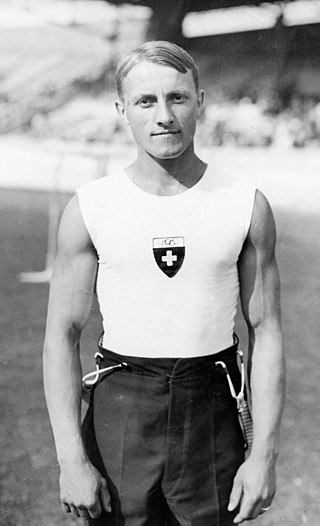
The men's artistic individual all-around event was part of the gymnastics programme at the 1928 Summer Olympics. It was one of seven gymnastics events for men and was the seventh Olympic men's all-around gymnastic championship. Scores from the individual apparatus events were added to give aggregate scores for the individual all-around; individual all-around scores were similarly summed for the team all-around event. There were 88 competitors from 11 nations. Each nation sent a team of 8 gymnasts. The event was won by Georges Miez of Switzerland, with his countryman Hermann Hänggi taking silver. They were the first medals in the event for Swiss gymnasts since 1904 and the first gold medal ever for a Swiss man in the individual all-around. Defending Olympic champion Leon Štukelj of Yugoslavia finished with the bronze this time, making him the third man to win multiple medals in the event.














